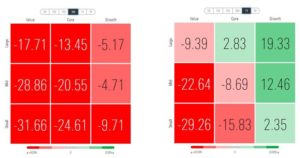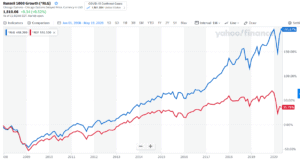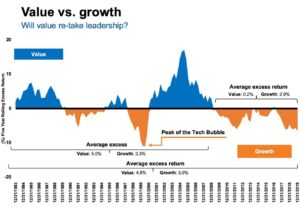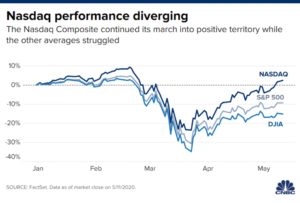Diversification: U.S. Stocks – Growth vs. Value
In the midst of the current market turbulence, many of our clients are paying more attention to financial markets and their investment portfolios than they otherwise typically might. Rather than allowing headlines to influence our emotions, at PDS Planning we rely upon longer-term data and historical context to put the current environment into perspective and allow us to make more informed decisions.
In light of clients’ rekindled interest and heightened awareness, we thought it would be helpful to review some investing basics through the lens of our time-tested belief that “today’s headlines and tomorrow’s reality are seldom the same.” By sharing our objective outlook, we hope to alleviate some of our clients’ short-term emotional anxiety while achieving better long-term financial results for them. Be sure to read our previous Diversification posts for more information:
- Diversification: Stocks & Bonds
- Diversification: U.S. vs. International Stocks
- Diversification: U.S. Stocks – Large vs. Small
A Growth Stock is a company that is expected to grow at a rate faster than the market average. Generally, any earnings are invested back into the company with the goal of continued growth. In today’s market, many well-known growth stocks are technology companies including Amazon, Facebook, Alphabet (Google), Apple, and Tesla. The NASDAQ is thought to be a good representation of the performance of growth stocks since it’s made up primarily of tech companies.
A Value Stock is a company that is priced cheaply relative to its fundamental worth, taking into account dividends, book value, earnings, cash flow, etc. Generally, value stocks issue high dividends while having more attractive financial ratios (i.e. Price-to-Earnings, Price-to-Book). In contrast to high valuation growth stocks, value stocks are seen as a bargain. The Dow Jones Industrial Average holds many of the most common value stocks. Some examples include Bank of America, Proctor and Gamble, Johnson and Johnson, Coca-Cola Company, and JPMorgan Chase.
Growth vs. Value: Short- & Medium-Term
From the perspective of the financial markets, 2020 has been extremely volatile with massive swings up and down. Comparing the year-to-date return of the Nasdaq (primarily growth stocks) to the Dow Jones (primarily value stocks), growth stocks have outperformed.
Telling the same story with a different visual, observe the growth outperformance over the 3-month time horizon as well as the 1 year.

In this relatively short recent time frame, it has certainly paid off for investors to be invested in growth instead of value. Growth stocks have lost less during down markets and gained more during upward moving markets.
In fact, growth has significantly outperformed value since the end of the Great Recession in 2008/09. In the chart below, “Growth” (blue line) is represented by the Russell 1000 Growth Index (^RLG) and “Value” (red line) is represented by the Russell 1000 Value Index (^RLV).

However, this is not the whole story.
Growth vs. Value: Long-Term
Like our other diversification posts before, to better understand the differences in growth and value we must look at the data from a historical context. While the short-term and medium-term story being told is to invest in growth, the long term story is different. The chart below dates back to 1983. The blue peaks show times of value performing better than growth while the orange shows growth beating value.

From 1983 through the end of 2019, value has actually performed better than growth, even with the growth outperformance since 2008.
If we take an even bigger step back and look at growth compared to value from 1936 a similar story is told. When the dark blue line is above the ‘average’ line running through the middle, value has outperformed growth.

Time & Diversification
Has it been better to invest in the high flying, cash burning growth stocks, or the dividend paying, cheap value stocks? If you’re someone who started investing money 40+ years ago, the answer appears to be value. But, if you started investing within the last 10 years, the answer appears to be growth.
What does this tell us about the future? It tells us and reminds us of the importance of diversification; by investing in a blend of growth AND value. Over shorter periods of time, asset class returns can vary widely; however, long-term investors are typically rewarded for thoughtful portfolio diversification. It is important to maintain a diversified portfolio for the opportunity to take advantage of all asset class returns. Maintaining a diversified allocation that is consistent with your long-term goals, combined with periodic rebalancing, has consistently resulted in beneficial long-term financial outcomes.
PDS Planning continues to be available to both our existing clients and prospective clients who can benefit from the financial planning and investment management services we provide. Please contact us if you have any questions or would like to discuss ways we may be able to assist you in providing clarity during these uncertain times.
Please remember that past performance may not be indicative of future results. Different types of investments involve varying degrees of risk, and there can be no assurance that any specific investment, strategy, or product or any non-investment related content, made reference to directly or indirectly in this newsletter, will be suitable for your individual situation, or prove successful. This material is distributed by PDS Planning, Inc. and is for information purposes only. Although information has been obtained from and is based upon sources PDS Planning believes to be reliable, we do not guarantee its accuracy. It is provided with the understanding that no fiduciary relationship exists because of this report. Opinions expressed in this report are not necessarily the opinions of PDS Planning and are subject to change without notice. PDS Planning assumes no liability for the interpretation or use of this report. Consultation with a qualified investment advisor is recommended prior to executing any investment strategy. No portion of this publication should be construed as legal or accounting advice. If you are a client of PDS Planning, please remember to contact PDS Planning, Inc., in writing, if there are any changes in your personal/financial situation or investment objectives. All rights reserved.

